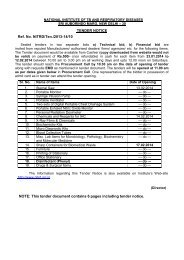The Indian Journal of Tuberculosis - LRS Institute of Tuberculosis ...
The Indian Journal of Tuberculosis - LRS Institute of Tuberculosis ...
The Indian Journal of Tuberculosis - LRS Institute of Tuberculosis ...
Create successful ePaper yourself
Turn your PDF publications into a flip-book with our unique Google optimized e-Paper software.
6 V. SIVARAMAN ETAL<br />
Clinical Aspects<br />
Pitchenick and Rubinson 15 have made the<br />
following detailed observations on 23 adult<br />
patients who had culture proved tuberculosis and<br />
acquired immuno-deficiency syndrome:<br />
(1) Chest radiographs resemble frequently<br />
the pattern <strong>of</strong> primary tuberculosis, i.e. hilar or<br />
mediastinal adenopathy with or without<br />
cavitation; pulmonary infiltrates are located with<br />
approximately equal frequency in the upper and<br />
lower lung fields; sputum cultures for M.<br />
tuberculosis are frequently positive; pleural<br />
effusions are infrequent and small while<br />
extrathoracic (especially lymphatic) tuberculosis<br />
is very common, probably part <strong>of</strong> a generalised<br />
lymphatic tuberculosis.<br />
(2) Patients may present with or develop<br />
miliary TB while under observation.<br />
(3) Other concurrent pulmonary infections<br />
(e.g. Pneumocystis carinii pneumonia) are<br />
common and confound the radiographic<br />
diagnosis <strong>of</strong> pulmonary tuberculosis. In this<br />
situation, rapidly changing pulmonary infiltrates<br />
suggest a non tuberculous infection and hilar or<br />
mediastinal adenopathy may serve as a clue to the<br />
co-existence <strong>of</strong> tuberculosis.<br />
(4) Patients may have positive sputum<br />
cultures for M. tuberculosis or active extra<br />
thoracic or disseminated tuberculosis even<br />
though the chest radiographs are normal.<br />
(5) Despite the immuno-suppressed state,<br />
the chest radiographic abnormalities clear within<br />
months <strong>of</strong> starting anti-tuberculosis drug therapy.<br />
(6) Patients with AIDS and mycobacterial<br />
disease, frequently, do not show the typical<br />
granulomatous tissue reaction. This may explain<br />
the absence <strong>of</strong> pulmonary cavitation and rapid<br />
radiographic clearing <strong>of</strong> tuberculous infiltrates<br />
after drug therapy without evidence <strong>of</strong> scaring.<br />
<strong>The</strong> presence <strong>of</strong> tissue granulomas may denote a<br />
better state <strong>of</strong> body immune defences.<br />
Two closely related non-chromogenic<br />
mycobacteria (Runyon's group III)-M. avium<br />
and M intracellulare grouped together as<br />
Mycobacterium avium complex (MAC) have been<br />
isolated from patients with HIV infection in the<br />
United States and other developed countries,<br />
more <strong>of</strong>ten than other mycobacteria including the<br />
more virulent M. tuberculosis, although the<br />
reverse is true in Central Africa and other<br />
developing countries 4 ' However, the clinical<br />
significance <strong>of</strong> the recovery <strong>of</strong> these mycobacteria<br />
from the lungs alone remains uncertain, while the<br />
identification <strong>of</strong> these organisms in lymphnodes,<br />
bone marrow or blood is persuasive evidence <strong>of</strong><br />
the presence <strong>of</strong> disseminated disease. But the<br />
clinical relevance <strong>of</strong> disseminated disease with M<br />
avium complex in patients with AIDS is not clear.<br />
<strong>The</strong> currently available anti-mycobacterial agents<br />
do not, usually, produce clinical improvement or<br />
microbiologic cure.<br />
<strong>The</strong>rapeutic Aspects<br />
<strong>The</strong> standard anti-tuberculosis drugs are<br />
extremely effective in TB patients with HIV<br />
infection. <strong>The</strong> recommended regimen for treating<br />
tuberculosis in HIV infected adult patients is<br />
Isoniazid, Rifampicin and Pyrazinamide but<br />
Ethambutol may also be used if Isoniazid<br />
resistance is suspected. <strong>The</strong> CDC and the<br />
American Thoracic Society have recommended<br />
that treatment be given for at least six months<br />
beyond the conversion <strong>of</strong> sputum culture to<br />
negative in patients with HIV infection and<br />
pulmonary tuberculosis 16<br />
Adverse reactions to anti-tuberculosis<br />
medicaments necessitating a change in therapy<br />
occurred in 25% <strong>of</strong> Chaisson's patients 8 .<br />
Mortality in patients with tuberculosis and<br />
AIDS is high in the different reported series : the<br />
median survival from the time <strong>of</strong> tuberculosis<br />
diagnosis was 7.4 months and from the time <strong>of</strong><br />
AIDS diagnosis 8.1 months in Chaisson's series.<br />
<strong>The</strong> cause <strong>of</strong> death was almost always AIDS, not<br />
tuberculosis.<br />
Efforts to treat HIV infection and AIDS have<br />
been directed towards inhibition <strong>of</strong> virus<br />
replication and restoration or stimulation <strong>of</strong> the<br />
impaired immune function 17 - Restoration <strong>of</strong><br />
immunity has been attempted by bone marrow<br />
transplantation or lymphocyte transfusion and by<br />
lymphokine administration. Immune-stimulatory<br />
drug therapy has also been proposed for<br />
increasing immune functions in HIV infected<br />
persons. Preliminary reports on isoprinosine in<br />
patients with generalised lymphadenopathy or the<br />
AIDS related complex have shown a transient<br />
improvement in the natural killer cell functions 18

















